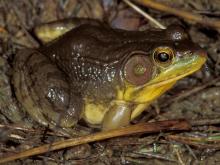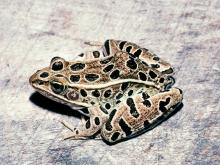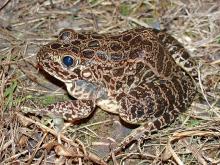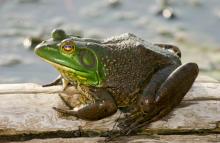Reptiles and Amphibians
Media

Species Types
Scientific Name
Notophthalmus viridescens louisianensis
Description
A small, olive-brown salamander with a fascinating life cycle, the central newt lives in and around woodland ponds and swamps in all but our far northwestern counties.
Media

Species Types
Scientific Name
Pantherophis ramspotti
Description
The western foxsnake is a moderately large snake with distinct brown blotches. In Missouri, it is rare and found only in our far northwestern counties.
Species Types
Scientific Name
Pantherophis vulpinus
Description
The eastern foxsnake is extremely similar to the western foxsnake and is mainly identified by its different geographic distribution: in Missouri, this rare species is found only in a few counties along the Mississippi River floodplain north from St. Louis.
Media

Species Types
Scientific Name
Nerodia sipedon sipedon (northern watersnake) and N. s. pleuralis (midland watersnake)
Description
The northern watersnake and midland watersnake are Missouri's two subspecies of common watersnake. Together they occur statewide. Color is variable: gray, tan, or reddish brown with dark crossbands or blotches. The belly is cream-colored with red, brown, or black spots or half-moon markings.
Media

Species Types
Scientific Name
Lithobates clamitans (formerly Rana clamitans)
Description
The green frog looks similar to a bullfrog but is smaller and has a ridge of skin along the sides of the back that is not found on bullfrogs. It is a game animal in Missouri.
Media

Species Types
Scientific Name
Lithobates pipiens
Description
The northern leopard frog is a medium-sized frog with dark spots on the back. Two skin folds run down each side of the back. In Missouri, it only occurs in a few northwestern counties along the Iowa border.
Media

Species Types
Scientific Name
Lithobates sphenocephalus (formerly Rana sphenocephala)
Description
The southern leopard frog is an excellent jumper and quickly leaps into water when startled. From March through July, the males make chuckling or quacking calls from shallow water. Occurs statewide except for the northwestern corner.
Media

Species Types
Scientific Name
Lithobates blairi (formerly Rana blairi)
Description
A medium-sized spotted frog, the plains leopard frog lives in pastures, prairies, and marshes. The ridge of skin along each side of the back is broken, and a small hind section of it is shifted upward. It occurs nearly statewide, including the Bootheel, but is only rarely present in the Ozarks.
Media

Species Types
Scientific Name
Lithobates areolatus circulosus
Description
A very secretive species, the northern crawfish frog spends most of its time hidden burrows, typically those made by crayfish. It is restricted to native prairie or former prairie areas and is a species of conservation concern in Missouri.
Media

Species Types
Scientific Name
Lithobates catesbeianus (formerly Rana catesbeiana)
Description
The American bullfrog is Missouri’s largest frog. This common species is easy to hear on warm nights when the males call a deep, sonorous “jug-a-rum, jug-a-rum” that can be heard from half a mile away.
See Also
About Reptiles and Amphibians in Missouri
Missouri’s herptiles comprise 43 amphibians and 75 reptiles. Amphibians, including salamanders, toads, and frogs, are vertebrate animals that spend at least part of their life cycle in water. They usually have moist skin, lack scales or claws, and are ectothermal (cold-blooded), so they do not produce their own body heat the way birds and mammals do. Reptiles, including turtles, lizards, and snakes, are also vertebrates, and most are ectothermal, but unlike amphibians, reptiles have dry skin with scales, the ones with legs have claws, and they do not have to live part of their lives in water.





















